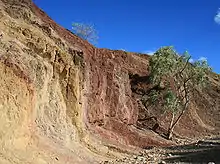Earth pigment
Earth pigments are naturally occurring minerals containing metal oxides, principally iron oxides and manganese oxides, that have been used since prehistoric times as pigments. The primary types are ochre, sienna and umber.[1]

Earth pigments are known for their fast drying time in oil painting, relative inexpensiveness, and lightfastness. Cave paintings done in sienna still survive today.
Production
After mining, the mineral used for making a pigment is ground to a very fine powder (if not already in the form of clay), washed to remove water-soluble components, dried, and ground again to powder. For some pigments, notably sienna and umber, the color can be deepened by heating (calcination) in a process known as "burning", although it does not involve oxidation but instead dehydration.
References
- Hirst, Kris (15 April 2017). "Ochre - The Oldest Known Natural Pigment in the World". thoughtco.com. ThoughtCo. Retrieved 31 August 2017.
